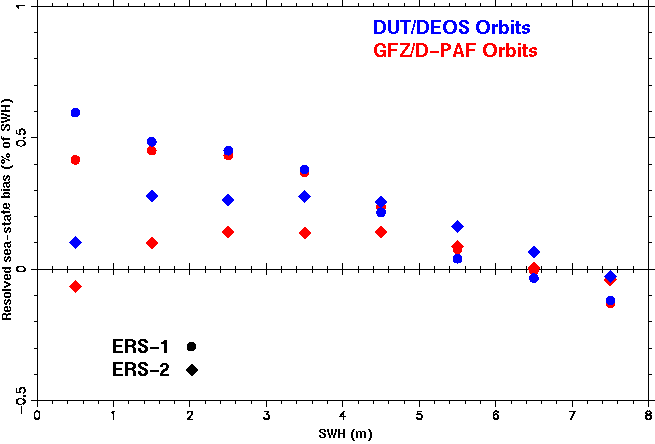
Effect of orbit precision on ERS Sea State Bias models
This page presents the results of a small study into the possible aliasing of orbit errors into parameters of sea state bias models correcting ERS-1 and ERS-2 altimeter range measurements depending on sea state and wind speed.
The data
The results obtained here are based on the latest Version 6 Ocean Product (OPR) provided by CERSAT. Corrections include (corrections in bold face are not provided on the OPR data sets):
- Time tag correction of -1.5 and -1.3 ms for ERS-1 and ERS-2, respectively
- GFZ/D-PAF PGM055 or DUT/DEOS DGM-E04 precise orbits
- Radiometer wet tropospheric correction
- ECMWF Dry tropospheric and Bent ionospheric corrections
- Gaspar and Ogor [1996] Sea state bias corrections:
SSB(ERS-1)=SWH(-0.047 - 0.0035 U + 0.000160 U2)
SSB(ERS-2)=SWH(-0.048 - 0.0026 U + 0.000126 U2)
- Grenoble FES95.2.1 ocean tide and loading
- Solid earth and pole tide
- OSUMSS95 mean sea surface
After editing all measurements are converted to single-satellite crossover height differences spanning the period of 20 June 1995 till 2 June 1996 and with a maximum time interval of 17.5 days between ascending and descending tracks.
The approach
From this data we estimate the coefficient b in the simple BM1-type sea state bias model in addition to the models given above:
SSB = b * SWH
In fact, we have enhanced this model by estimating one coefficient bi for each SWH interval of 1 meter. Assuming the crossover height differences are due to errors in the bi coefficients, this leads to observation equations:
Crossover difference = SSH1 - SSH2 = SSB1 - SSB2 = bi * SWH1 - bj* SWH2
The coefficients bi (i=1...8) are solved for in a least squares minimisation of all crossover height differences.
The two alternative orbit solutions have fairly different radial precision (GFZ/D-PAF approximately 6-7 cm and DUT/DEOS approximately 4-5 cm) and differ radially by about 5 cm rms. This provides the opportunity to test the effect of orbit errors on the sea state bias estimation. At the same time, we can validate the original Gaspar and Ogor [1996] BM3-type model.
The results
The table below lists the bi coefficients (in percents) obtained from the analysis of the crossover height differences, for ERS-1 and ERS-2 and based on DUT and GFZ orbits. The one-but-last line gives the effect of the corrections to the SSB model: the variance of the changes to the derived sea height implied by these corrections. The bottom line gives the overall value in case only one b coefficient was estimated, as in a true BM1 model.
| SWH | ERS-1 | ERS-2
|
| (m) | number | DUT | GFZ | number | DUT | GFZ
|
| 0-1 | 90709 | 0.595 | 0.415 | 42695 | 0.103 | -0.066
|
| 1-2 | 254463 | 0.484 | 0.450 | 198712 | 0.278 | 0.099
|
| 2-3 | 215105 | 0.450 | 0.432 | 207745 | 0.263 | 0.141
|
| 3-4 | 115812 | 0.380 | 0.368 | 122849 | 0.276 | 0.137
|
| 4-5 | 52027 | 0.216 | 0.237 | 62725 | 0.256 | 0.141
|
| 5-6 | 20668 | 0.040 | -0.006 | 28233 | 0.162 | 0.086
|
| 6-7 | 7343 | -0.033 | -0.130 | 11542 | 0.065 | 0.003
|
| 7-8 | 2471 | -0.119 | -0.227 | 4307 | -0.117 | -0.040
|
| Var (cm2) | | 0.376 | 0.352 | | 0.192 | 0.050
|
| 0-8 | 758598 | 0.370 | 0.355 | 678808 | 0.244 | 0.118
|
The values are presented in graphical form below. Circles are for ERS-1, diamonds for ERS-2. Blue (light grey) markers are for DUT orbits, red (dark grey) markers for GFZ orbits.

The conclusions
- The adjustments to the Gaspar and Ogor sea state bias models are of the order of 0.2 to 0.4% of SWH and would result in a 0.05 to 0.38 cm2 correction to the sea surface height. Naturally, the adjustments do not include effects of windspeed, but results show a clear tendency that the current sea state bias is underestimated for the range of 1-5 meters of SWH.
- Both the trend of the SSB as a function of SWH and the overall implied variance are similar to the differences found between a BM3 and BM4 model. Yet, the variances appear too small to warrent the selection of a BM4 over a BM3 model.
- Remarkably, the selection of the orbit (DUT or GFZ) does have little effect on the ERS-1 sea state bias adjustments, but certainly has a considerable impact on the ERS-2 results. In the later case the estimated adjustments are about 0.1% for SWH up to 5 meter.
- The effect of orbit error on the SSB coefficient also urge for caution in generating SSB models and prevailing one over the other. The SSB estimation still is quite sensitive to many external effects.
Acknowledgements
Thanks to Philippe Gaspar for his comments.
 Questions or comments:
Remko Scharroo, remko.scharroo@lr.tudelft.nl.
20 May 1997.
Questions or comments:
Remko Scharroo, remko.scharroo@lr.tudelft.nl.
20 May 1997.



 Questions or comments:
Remko Scharroo, remko.scharroo@lr.tudelft.nl.
20 May 1997.
Questions or comments:
Remko Scharroo, remko.scharroo@lr.tudelft.nl.
20 May 1997.